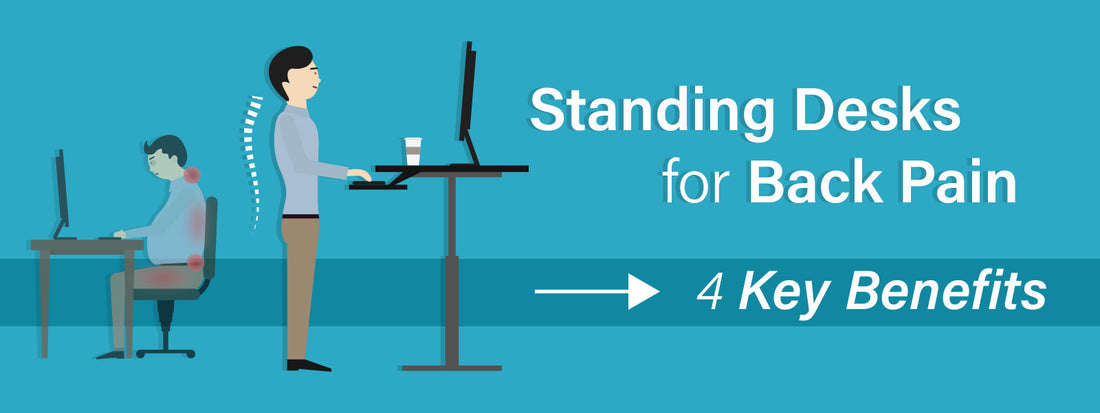
Standing Desks For Back Pain - 4 Key Benefits
Standing Desks and Lower Back Pain - You Can Feel Better!
NEWS FLASH: Back pain in America is an epidemic.
Okay, maybe that’s not news, but at any given moment there are 31 million Americans suffering from debilitating lower back pain, according to the ACA. In fact, back pain is one of the most common reasons for missed work, and roughly one-half of working Americans report having back pain each year.
Back pain accounts for over 264 million lost work days per year, here in un the US - 2 full work days for every full-time employee in the country.
And, treating back pain is not cheap. Low-back pain alone costs Americans at least $50 billion in health care costs each year. When you factor in lost wages and decreased productivity, the total cost of back pain equals more than $100 billion a year.
The problem isn’t just physical - it’s a drain on our economy!
What’s most interesting about the back pain epidemic in America is that most cases of back pain are considered mechanical or non-organic - meaning they aren’t caused by the serious conditions you’d expect, such as inflammatory arthritis, infection, fracture or cancer.
Instead, most back pain is caused by everyday behavior, such as excessive sitting, slouching while sitting, and bending forward to look at screens. This is especially problematic considering the average full-time employee spends 8.5 hours a day at work sitting in front of their desk, along with another 100 hours a year sitting during their commute.
In this article, we're going to explain the 4 key ways that a standing desk will help you reduce your back pain.
*We should offer one key disclaimer: it may take more than just a standing desk to fix your back problems. We strongly recommend that anyone experiencing back pain go see a qualified chiropractor, ASAP. And make sure that your Chiropractor doesn't just do "Adjustments." A good chiropractor should pay special attention to, and help rehab the soft tissues in your body (muscles, tendons and ligaments) - not just your spine.
1. Standing Increases Range of Motion and Mobility
Consider the position of your body when you sit: hips bent at 90 degrees, knees bent at 90 degrees, and body and spine compressed into a “shortened” position. The body was not meant to stay in this position for extended periods of time.
But nevertheless, this is how the average American spends a majority of their day. And as the hours sitting accumulate, the body begins to adapt (or maladapt) until our normal normal human movements become unfamiliar to the body. Your body now thinks that sitting is it’s normal position.
So over time, your muscles and tissues adapt by condensing and tightening - essentially pulling up all the loose slack in your body, caused by the 90 degree sitting position. Then when we stand, all of those shorter muscles are now pulled tight - tugging on various parts of the body that lead to back pain.
The Psoas (muscles connecting the front of your hips to your lower spine) pull the lower spine forward, and cause the hips to tilt forward.
The hamstrings tug on the pelvis, also causing the pelvis to tilt and and creating extra curve in the lower spin.
The quads pull on the knees, the hips pull on the ankles, the calves pull on the hamstrings… your tissues become so tight and imbalanced that they pull your body into bad posture, now matter how hard you try to fight it.
In your spine, the primary result is subluxation - which is just a fancy way of saying that your vertebrae get pulled out of alignment with the rest of your spine. This causes the discs in your back to fail, nerves to get pinched, and can send pain radiating throughout the body (depending on which vertebrae gets pulled out of place).
These subluxations can even lead to other downstream health issues, as the nervous system fails to send signals throughout the body, necessary for our vital systems to work. It’s all bad news!
Adding a standing desk allows us to drastically reduce our time spent sitting, and adds more subtle movement to our day. As we sit less and move more, our tissues slowly begin to return to their normal human state. Muscles and tissues elongate and regain their natural flexibility, allowing our spines to reform their normal posture.
It’s important to keep in mind that we can’t counteract years or decades of excessive sitting, within days of using a standing desk. It takes time to readapt to standing, and we strongly recommend working with a chiropractor, to help speed up the adaptation process.
2. Standing Strengthens and Engages Your Muscles
The other way that our body negatively adapts to sitting, is by shifting energy away from the muscles that we no longer use.
The primary suspects: your glute muscles (in your butt) and your abs. All that sitting tells the body that it doesn’t really use those muscles any more, and so the body allows them to atrophy and lose strength.
However, it doesn’t have the same effect on our quads, which now become overburdened by modern life, creating an imbalance between the front and back of your core.
The result of that imbalance once again places unwanted burden on your spine, causing the pelvis and lower spine to pull out of place, and leading to all the same subluxation problems we discussed above.
When we stand and move more throughout the day (with the help of a standing desk), our body has to keep all muscles of the core engaged, which helps to rebalance those muscles back to their normal state.
One extra word of advice - you might need to retrain your body to use those muscles in the early days. So as you get used to standing in front of your desk, be sure to keep your butt engaged and your knees bent. One simple way to do this is to imagine “Screwing your feet into the ground.” So imagine pushing your toes to the outside, and pulling your heels to the inside. Your feet won’t actually move (the should be straight or angled out just slightly), but the act of twisting will naturally engage your core muscles.
3. Standing and Moving Helps Lubricate the Discs in Your Spine
Your discs are the cartilage in your spine that act as cushions between each vertebrae. Without them, our vertebrae would rub bone on bone, pinching nerves in between, and causing a good deal of pain. Sadly, this is a fairly normal phenomenon - typically caused by subluxation (spine being out of alignment) or by a lack of movement in the spine.
If our spine stays out of alignment for too long and/or doesn’t receive enough movement, the discs in our spin dry up and fail to give us the cushioning we need. This can lead to a great deal of chronic pain, and in some cases spinal fusion might be necessary.
Using a standing desk helps keep our spine in proper alignment (as we outlined above), but also helps keep the discs mobile and lubricated, so they can cushion your spine the way they were meant to.
For added help, we also recommend a standing desk mat to cushion the joints and spine.
4. Standing Keeps the Body in a Better Posture
At this stage of the article, this point may be a bit redundant, but we wanted to state this clearly nonetheless.
For all the reasons we discussed above, sitting causes poor posture - and it also puts stress on the upper spine as well.
Standing in front of our desks (and sitting less) helps us to avoid slouching, and a normal standing desk posture reduces forward head tilt, and helps create a more natural arch in our spine.
It may take a little time to adapt. In fact, we’ve even had a couple customers ask to return their desk, because the act of standing was initially uncomfortable for them. But over time, the body will almost always readjust, and we can start to feel human again.
A word of advice - a good monitor arm can help. Even if you’re standing, it’s still important to make sure that your monitors are at eye level, so you’re not looking down to see your screens.
Wrap Up
Let’s just make this simple. We all know that sitting puts strain on our back. The important thing is that we do something about it before it’s too late.
In the short term, sitting leads to pain and injury in the neck and back (particularly if you’re an athlete).
But if we don’t do anything to reduce our time spent sitting, the long term effects can be much worse - even chronic.
Don’t let your work be a source of long-term pain and discomfort. Invest in a standing desk now, and start your journey back to feeling human again!
*Did you know that standing desks can also help with weight loss? Click here to learn more about the science behind standing desks, and how they can be a helpful part of any weight loss or weight management program.
*To learn more about ALL the positive benefits of using a standing desk - including whether there might be any disadvantages of a standing desk - click here.
References:
- Deskbound: by Kelly Starrett
- NCBI Study: The Continuing and Growing Epidemic of Chronic Low Back Pain
- American Chiropractic Association: Back Pain Facts and Statistics
- The Bone and Joint Initiative: The Hidden Impact of Musculoskelatal Disorders on Americans
- NCBI Study: Lumber disc disorders and low-back pain: socioeconomic factors and consequences
